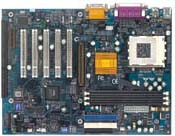Gigabyte GA-7ZX Socket-A KT133 ATX
by Mike Andrawes on July 15, 2000 7:47 PM EST- Posted in
- Motherboards
Gigabyte has always been one of the first in line to help AMD with their latest CPU, the Athlon. At the launch last year, Gigabyte's GA-7IX was one of the first boards to support the new chip and was eventually included in AMD's evaluation systems. When it was time for the release of VIA KX133 chipset for the Athlon, Gigabyte was there again with one of the first boards, this time the microATX GA-7VM.
More recently, Gigabyte had the first widely available KT133 board to support AMD's new Socket-A processors, the Athlon with on-die cache (aka "Thunderbird") and the Duron. Just like the release of the KX133, Gigabyte actually had a line of boards planned around the chipset, but the first out was the microATX version, the GA-7ZM in this case. The follow up is the GA-7ZX, which is a full ATX version of the GA-7ZM.
|
Motherboard Specifications |
|
| CPU Interface |
Socket-A
|
| Chipset |
VIA KT133
|
| Form Factor |
ATX
|
| Bus Speeds |
95
/ 100 / 105 / 110
113 / 115 / 117 / 133 |
| Voltages Supported |
Auto Detect
|
| Memory Slots |
3 168-pin DIMM Slots
|
| Expansion Slots |
1 AGP Slot
5 PCI Slots (5 Full Length) 1 AMR Slot (Shared) 1 ISA Slot (Shared) |
| Onboard Sound |
Sigmatel
STAC9708T AC 97
Creative CT5880 (optional) |
| BIOS |
AMI Simple Setup 1.21
Gigabyte DualBIOS |
The Good
The GA-7ZX is the followup to Gigabyte's first Socket-A motherboard, the GA-7ZM. Following the same pattern of their KX133 releases, the GA-7ZX features a PCB that's virtually identical to its little brother, the GA-7ZM, but of course it's a full ATX board instead of microATX. That means there is room for a few added features, primarily in the expansion department. This time around, we get a 5/1/1/1 (PCI/ISA/AGP/AMR) expansion slot configuration that should satisfy just about everyone, while hardware-based Creative Labs PCI sound is now optional. Interestingly, it is the ISA and AMR slot that is shared on the GA-7ZX.
ISA slots are becoming increasingly scarce these days, but they're not gone just yet. We know a lot of people still have various ISA peripherals that serve their purpose just fine. Thanks to the PCI-ISA bridge integrated in the VIA 686A Super South Bridge, it costs Gigabyte little more than the cost of the physical connector to implement that ISA slot.
Like just about every other motherboard on the market today, the AGP slot is a "universal AGP slot," which means it isn't keyed specifically for AGP 2X or AGP 4X cards, allowing the user to install virtually any currently available AGP card in the slot, whether it is an AGP 1X/2X or 4X card. Gigabyte adds a nice little feature to the AGP slot - an AGP retention mechanism. Apparently some OEM's were having trouble with AGP cards coming loose during shipping, so the retention mechanism serves to make sure this doesn't happen.
Located between the Socket-A connector and the AGP slot is the KT133's North Bridge, which is covered by Gigabyte's classic orange heatsink. The 8373 North Bridge is nearly identical to the 8371 of the KX133 with a few timing changes to support AMD's Socket-A CPU's. That North Bridge provides all the features of the KT133, most importantly 133MHz memory bus and AGP 4X support. The beauty of the 8373's memory controller is that it can run your memory at either 133MHz or 100MHz using a multiplier of the FSB frequency. So those users with PC133 SDRAM can take advantage of the increased bandwidth (1.06GB/s vs. 800MB/s) over PC100 SDRAM, while allowing backwards compatibility with older PC100 SDRAM. Support for VC100/VC133 memory is still included, but availability is still weak and prices high.
The GA-7ZX, as is the case with most Athlon motherboards, features 3 DIMM slots capable of accepting PC100/PC133 or VC100/VC133 SDRAM running at either a 3:3 (1:1) ratio with the FSB (by default, 100MHz) or a 4:3 ratio with the FSB (133MHz by default). This is the recommended maximum for PC133 support according to VIA.











0 Comments
View All Comments